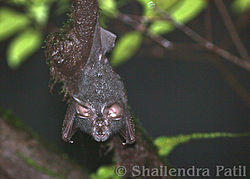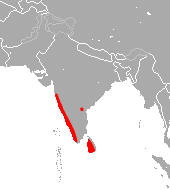| Lesser woolly horseshoe bat | |
|---|---|
 | |
| Scientific classification | |
| Kingdom: | Animalia |
| Phylum: | Chordata |
| Class: | Mammalia |
| Order: | Chiroptera |
| Family: | Rhinolophidae |
| Genus: | Rhinolophus |
| Species: | R. beddomei |
| Binomial name | |
| Rhinolophus beddomei Andersen, 1905 | |
 | |
| Lesser woolly horseshoe bat range | |
The lesser woolly horseshoe bat (Rhinolophus beddomei), also called Beddome's horseshoe bat, is a species of bat in the family Rhinolophidae. It is found in India and Sri Lanka. Its natural habitats are subtropical or tropical moist lowland forests, caves, and urban areas.
